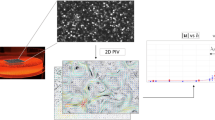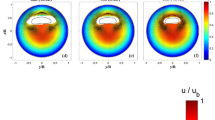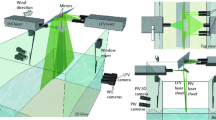Abstract
Initial effort is made to establish a new technique for the measurement of three-dimensional three-component (3D3C) velocity fields close to free water surfaces. A fluid volume is illuminated by light emitting diodes (LEDs) perpendicularly to the surface. Small spherical particles are added to the fluid, functioning as a tracer. A monochromatic camera pointing to the water surface from above records the image sequences. The distance of the spheres to the surface is coded by means of a supplemented dye, which absorbs the light of the LEDs according to Beer–Lambert’s law. By applying LEDs with two different wavelengths, it is possible to use particles variable in size. The velocity vectors are obtained by using an extension of the method of optical flow. The vertical velocity component is computed from the temporal brightness change. The setup is validated with a laminar falling film, which serves as a reference flow. Moreover, the method is applied to buoyant convective turbulence as an example for a non stationary, inherently 3D flow.










Similar content being viewed by others
Notes
Though Debaene et al. (2005) were interested in the flow field close to a rigid wall, the authors of this paper ultimately want to measure the velocity field close to a free surface. As long as this surface is not bent, the coordinate z represents the distance of the particle’s surface, which is orthogonal to the flat surface.
References
Agüi JC, Jimenez J (1987) On the performance of particle tracking. J Fluid Mech 185:261–304
Banner ML, Phillips OM (1974) On the incipient breaking of small scale waves. J Fluid Mech 65:647–656
Bannerjee S, MacIntyre S (2004) The air–water interface: turbulence and scalar interchange. In: Liu PLF (eds) Advances in coastal and ocean engineering, vol 9. World Scientific, Hackensack, pp 181–237
Brücker C (1995) Digital-particle-image-velocimetry (dpiv) in a scanning light-sheet: 3d starting flow around a short cylinder. Exp Fluids 19:255–263
Bukhari SJK, Siddiqui MHK (2006) Turbulent structure beneath air–water interfaces during natural convection. Phys Fluids 18:035106
Cowen E, Monismith S (1997) A hybrid digital particle tracking velocimetry technique. Exp Fluids 22:199–211
Debaene P, Kertzscher U, Gouberits I, Affeld K (2005) Visualization of a wall shear flow. J Vis 8(4):305–313
Elsinga GE, Scarano F, Wieneke B (2006) Tomographic particle image velocimetry. Exp Fluids 41:933–947
Haussecker HW, Fleet DJ (2001) Computing optical flow with physical models of brightness variation. PAMI 23(6):661–673
Haußecker H, Jähne B (1997) A tensor approach for precise computation of dense displacement vector fields. In: Paulus E, Wahl FM (eds) DAGM. Springer, Braunschweig, pp 199–208
Hering F (1996) Lagrangesche Untersuchungen des Strömungsfeldes unterhalb der wellenbewegten Wasseroberfläche mittels bildfolgenanalyse. PhD Thesis, University of Heidelberg
van de Hulst HC (ed) (1981) Light scattering by small particles. Dover Publications, New York
Jähne B, Haußecker H (1998) Air–water gas exchange. Ann Rev Fluid Mech 30:443–468
Jehle M (2006) Spatio-temporal analysis of flows close to water surfaces. Diss, Univ Heidelberg
Li H, Sadr R, Yoda M (2006) Multilayer nano-particle image velocimetry. Exp Fluids 41:185–194
Maas HG, Gruen A, Papantoniou D (1993) Particle tracking velocimetry in three-dimensional flows. Part I: Photogrammetric determination of particle coordinates. Exp Fluids 15:133–146
Melville WK, Shear R, Veron F (1998) Laboratory measurements of the generation and evolution of langmuir circulations. J Fluid Mech 364:31–58
Okuda K (1982) Internal flow structure of short wind waves, part i–iv. J Oceanogr Soc Japan 38:28–42
Peirson WL, Banner ML (2003) Aqueous surface layer flows induced by microscale breaking wind waves. J Fluid Mech 479:1–38
Raffel M, Willert C, Kompenhans J (1998) Particle image velocimetry. A practical guide. Springer, Heidelberg
Rayleigh L (1916) On convection currents in a horizontal layer of fluid, when the higher temperature is on the under side. Philos Mag 32:529
Tropea C, Foss J, Yarin A (2007) Springer handbook of experimental fluid dynamics. Springer, Heidelberg, pp 8, 10, 11
Acknowledgments
We gratefully acknowledge the support by the German Research Foundation (DFG, JA 395/11-2) within the priority program “Bildgebende Messverfahren für die Strömungsanalyse”.
Author information
Authors and Affiliations
Corresponding author
Rights and permissions
About this article
Cite this article
Jehle, M., Jähne, B. A novel method for three-dimensional three-component analysis of flows close to free water surfaces. Exp Fluids 44, 469–480 (2008). https://doi.org/10.1007/s00348-007-0453-5
Received:
Revised:
Accepted:
Published:
Issue Date:
DOI: https://doi.org/10.1007/s00348-007-0453-5




